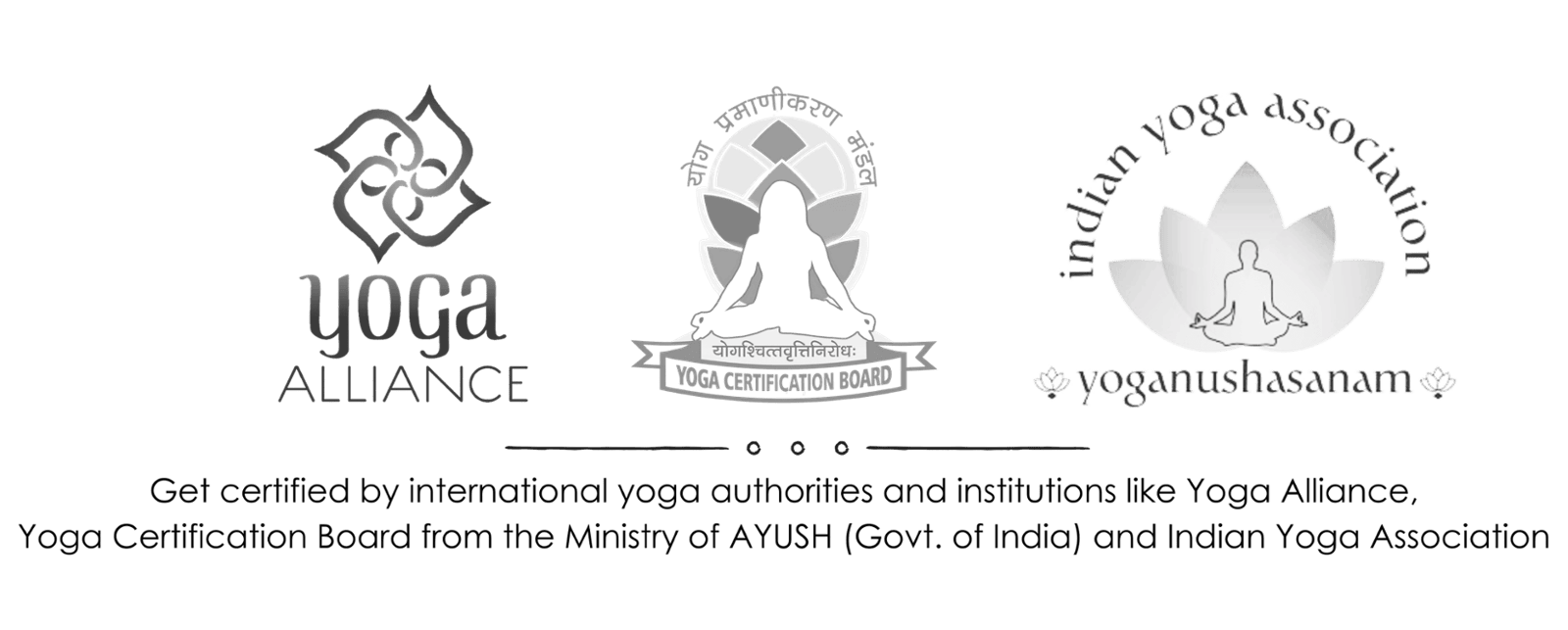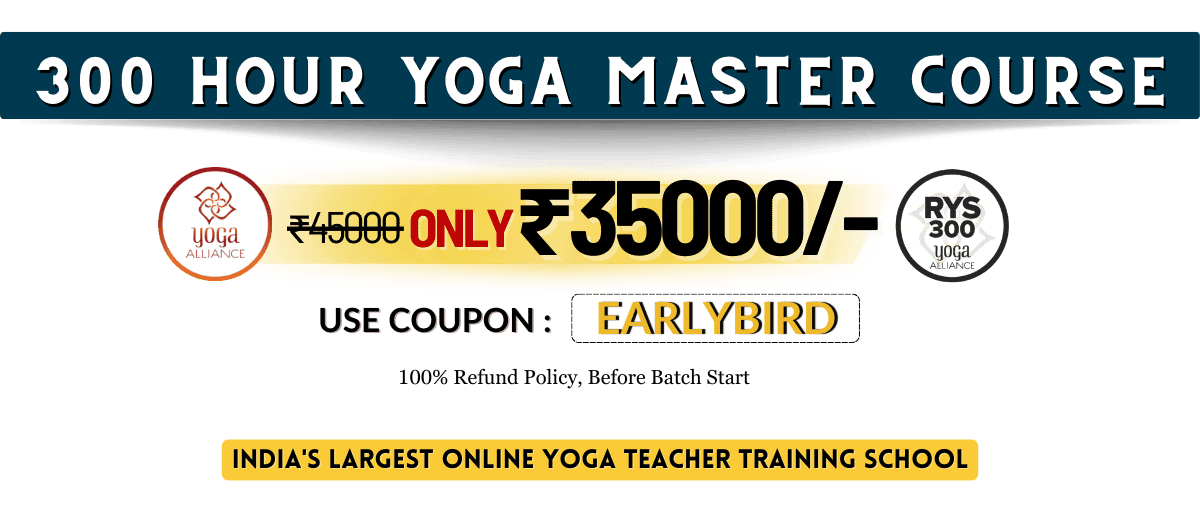

300 Hour Yoga Master Course
300 Hour Yoga Master Course
Every breath is an opportunity to grow—upgrade your yoga skills and unlock your full potential.
Upcoming Batch

What You'll learn
Syllabus Covered By YCB L3 & L4
Practical
Practical
- Concept and Recitation of Pranava & Hymns
- Recitation of Soham japa
- Selected universal prayers & invocations and Nishpatti Bhava.
- Shatkarmas: Vamana Dhauti (Kunjal), Vastra dhauti, Sutra Neti, Jala Neti, Vatkrama, Vyutkarma, Sheetkrama, Nauli, Trataka, Laghoo and Poorna sankhaprakshalana.
- Sukshma Vyayama, Sthula Vyayama and Suryanamaskar with Mantra (20+)
- 80+ Yogasana & Asana Alignment.
- Sectional Breathing (Abdominal, Thoracic and Clavicular Breathing) & Yogic Deep Breathing
- Surya Bhedi and Chandra Bhedi Pranayama, Anuloma Viloma/ Nadi Shodhana, Bhastrika Pranayama, Ujjai Pranayama , Sitali Pranayama, Sitkari Pranayama, Bhramari Pranayama (with Antar & Bahya Kumbhaka).
- Bandha- Jalandhara Bandha, Jivha Bandha, Uddiyana Bandha, Mula Bandha, Maha Bandha.
- Mudra- Yoga Mudra, Maha Mudra, Shanmukhi Mudra, Shambhavi mudra, Vipareetakarani Mudra
- Practice of Dhyana, Yoga Nidra, Antarmauna, Ajapa Dharana,
- Practices leading to Breath Meditation, Practices leading to Om Meditation, Practices leading to Vipassana Meditation, Practices leading to Preksha Meditation
Theory
Theory
- Etymology and Definitions of Yoga (Patanjala Yoga Sutra, Bhagavad Gita, Kathopanishad)
- Origin and General history and Development of Yoga( Pre vedic to contemporary Period) Definitions of Yoga in different Yoga texts, Aim, Objectives and Misconceptions about Yoga, True Nature and Principles of Yoga.
- Evolution of Yoga: Pre vedic to contemporary Period.
- Meaning and Objectives of Darshana; Branches of Indian Philosophy; Nature of Yoga in Bharatiya Darshana(Indian Philosophy); Salient Features of Shad Drashana; Distinction between Indian Philosophy and Western Philosophy. Essence of Samkhya Yoga and Vedanta Darshana ; General introduction to Nastika Darshana and their Practices.
- Introduction to Vedas and Upanishads, Prasthanatrayee & Purushartha Chatushtaya; Yoga in Epics - Ramayana, Mahabharata; Nature of Yoga in Smritis, Puranas, Aagamas and Tantras; Concept of Pancha-Kosha; concept of Nadi, Prana, Kundalini in Tantra, Elements of Yoga in Narada Bhakti Sutra.
- Elements of Yoga in Jainism(concept of syadvada, Ratnatrya, Kayotarga Buddhism(concept of Aryasatyas, Arya-ashtangika-marga & Vipasana)and Sufism, Sufi Meditation Techniques, Characteristics of Yoga in Sikhism, Elements of Sahaja Yoga or Nama Yoga of Guru Nanak.
- Yoga in Medieval period: Features of Natha Parampara, Bhakti Yoga of Medieval saints, Characteristics of Yoga in Narada Bhakti Sutras, Yoga in the Literature of SaintsKabirdas, Tulasidas and Surdas.
- Yoga in Modern times : Yoga Traditions of Sri Ramakrishna an Swami Vivekananda, Integral Yoga of Shri Aurbindo, Yoga of Maharishi Raman and Swami Dayanand Saraswati, Yoga Paramparas from modern to contemporary times, contribution of different Yoga guru in the development of Yoga.
- Yoga in Contemporary Times: Knowledge of Yoga Parmparas(lineages) of contemporary times; Yoga Parmpara of Yogacharya Sri T. Krishnamacharya, Swami Rama of Himalayas, Maharshi Mahesh Yogi, Swami Dhirendra Brahmchari and their contributions for the development and promotion of Yoga.
- Yoga Schools with Vedanta Tradition (Jnana, Bhakti, Karma, and Dhyana)
- Yoga Schools with Samkhya Yoga Tradition (Patanjali Yoga)
- Yoga Schools with Tantric Tradition (Hath Yoga, Swara Yoga and Mantra Yoga)
- Concept and Principles of Sukshma Vyayama, Sthula Vyayama, Surya Namaskars and their significance in Yoga Sadhana.
- Concept and Principles of Shatkarma: Meaning, Types, Principles and their significance in Yoga Sadhana.
- Concept and Principles of Yogasana: Meaning, definition, types and their significance in Yoga Sadhana.
- Concept and Principles of Pranayama: Meaning, definition, types and their significance in Yoga Sadhana.
- Introduction to Bandha & Mudra and their health benefits.
- Introduction to Yogic relaxation techniques with special reference to Yoga Nidra.
- Principle Upanishads: Introduction to Upanishads, Essence of Principle Upanishads ; Yogatattva in Principle Upanishads, Concept of Panchkosha, Tri-sharir, Omkara Upasana; Ashtanga Yoga in Principle Upanishad.
- Yogopanishads : Introduction to Yogopanishads ; Essence of Yogopanishads
- BhagavadGita: General Introduction to Bhagavad Gita (B.G.) and its traditional commentaries, their commentators, Essence of Bhagavadgita as a synthesis of karma, Bhakti and Jnana Yoga; concept of sthitaprajna stages and characteristic of it. Relevance of Samkhya Yoga and Atman(Purusha), Jivatman in Bhagavadgita and Jnana Yoga in the context of Bhagavadgita; concept of karma Yoga, Nishkam Karma and Karma Phala; Concept of Bhakti Yoga; features of Bhakt; Nature of Bhakti, Means and End of Bhakti-Yoga; Nature of Dhyana as described in Bhagavadgita; concept and classification of Ahara and Triguna as described in B.G; Importance of Bhagavadgita in day to day life
- Introduction to Patanjala Yoga Darshana, knowledge of Traditional commentaries and commentators of Patanjala Yoga Sutra, Metaphysics of Samkhya and its relationship with Yoga Darshana of Patanjali, Concept of Purusha Prakrati, twenty-five entities according to Samkhya, Tapatryas; Relationship between Samkya and Yoga Darshana, concept of Anthakaranas, Chitta, Chitta-Bhumis.
- Concept of, chitta-vritti, chitta-vritti-nirodhopaya, concept of Ishwar and its relevance in Yogasadhana, Qualities of Ishwar, Ishwaraparidhana. ChittaVikshepas (Antarayas)and concept of chitta-prasadanam, Relevance of Chittaprasadanam in Yoga Sadhana. Types and nature of Samadhi in Yoga Sutra, Ritambharaprajna and Adhyatmaprasada; Difference between Samapatti and Samadhi.
- Kriya Yoga of Patanjali, Concept of Kleshas, Heya, Hetu, Haana and Hanopaya,Viveka-khyati; Significance of each limb of Ashtanga Yoga.
- Knowledge of Hatha Yoga and Hatha Yoga Texts- Siddhasiddhanta paddhati, Hatha Pradeepika, Gheranda Samhita, Hatha Ratnavali and Shiva Samhita;Hathayogiparampara;
- Importance of Hatha and its secrecy prerequisites of Hatha Yoga (dasha yama and dasha niyama);
- Constructive (Sadhaka) and Destructives (Badhaka) tattvas in Hatha Yoga; Concept of Mattha, Mitaahara, Pathya and Apathya;
- Shatkarma :- Knowledge of shatkarma theirTechniques benefits, precautions and contraindications mentioned in different Hatha Yogic Texts; Application and relevance of shatkarma in modern Days;
- Yogasana: Knowledge of Yogasana, their Techniques, benefits, precautions and contraindications mentioned in different Hatha Yogic Texts; Application and relevance of Yogasana in modern Days;
- Pranayama: : Knowledge of Pranayama, their Techniques, benefits, precautions and contraindications mentioned in different Hatha Yogic Texts; Application and relevance of Pranayama in modern Days
- Bandha & Mudra: Knowledge of Bandha & Mudra their Techniques, benefits, precautions and contraindications mentioned in different Hatha Yogic Texts; Application and relevance of Bandha & Mudra in modern Days
- Concept of Pratyahara, Dharana, Dhyana and Samadhi in different Hatha Yoga Texts. Concept and importance of Nada and Nadanusandhana in HathaPradeepika, Four stages of Nadanusandhana; Relationship between Hatha Yoga and Raja Yoga.
- Introduction and Highlights of Yoga Vasishtha, Definitions of Yoga and their relevance. Concept of Mind: World is the projection of Mind; Manah Prashamanah upayah Yoga: Mind control through abhyasa (practice) and vairagya (detachment).
- Concept of Jnana: Jnana Saptabhumika, importance of knowledge and types of knowledge, Management of Mind and emotions-enhancing the power of discrimination (Viveka).
- Prana and Pranayama: Control of breathing; the story of Kakabhushanda, Understanding of the Concept of Adhi and Vyadhi;
- Concept of Samadhi and Moksha: Good Association; Self Enquiry; Development of Satvaguna (Good virtues), Eight Limbs of Meditation.
- Meaning and definition of Health and Disease, Concept of Adhi and Vyadhi, Yoga as a preventive Health care- Heyam dukham anagatam.
- Meaning and definition of Health and Disease, Concept of Adhi and Vyadhi, Yoga as a preventive Health care- Heyam dukham anagatam.
- Shuddhi Prakriyas in Yoga and their role in preventive and curative Health.
- Knowledge of Trigunas, Pancha-Kosha, Pancha-Prana and Shatkchakra and their role in Health and Disease.
- Yogic concept of Holistic Health and its importance in the management of Diseases.
- Concept of Health and Disease in Indian Systems of Medicine Naturopathy
- Education- Definition of Education, Salient features of Yoga Education; Factors of Yoga Education; Teacher, Student and Curriculum, Guru-shishya parampara and its importance in Yoga Education.
- Value Education, its meaning and definitions, types of values, value-oriented education and modes of living, role of value oriented education; contribution of Yoga towards development of values;
- Salient features of ideal Yoga teacher, role of Yoga teacher in value-oriented education, role of Yoga in development of human society; Yogic Concepts for the Development of Four Fold Consciousness - Civic Sense, Patriotic Urge, Service Zeal and Spiritual Growth.
- Teaching and Learning: Concept and Relationship between the two.
- Physio-psychology
- Definition & Importance of Health according to WHO; Dimensions of Health: Physical, Mental, Social and Spiritual level.
- Concepts of Trigunas, Pancha-mahabhutas, Pancha-prana and their role in Health and Healing; Concept of Pancha-koshas & Shat-chakra and their role in Health and Healing.
- Heyamdukhamanagatam; Potential causes of Ill-health: Tapatrayas and Kleshas, Physical and Physiological manifestation of Disease (Vyadhi, Alasya, Angamejayatva and Ssvasa-prashvasa); Role of Yoga in preventive health care.
- Mental and Emotional ill Health: Concept of Antarayas (Styana, Samshaya, Pramada, Avirati, Bhranti-darsana, Alabdha-bhumikatva, Anavasthitatva, Duhkha and Daurmanasya); Role of Yoga in Mental and Emotional Health.
- Yogic Diet - General Introduction of Ahara; Concept of Mitahara; Pathya and Apathya according to Gheranda Samhita, Hathapradeepika and Bhagavad Gita;Importance of Yogic Diet in Yog Sadhana and its role in healthy living; Diet according to the body constitution (Prakriti) – Vata, Pitta and Kapha as also Gunas.
- Yogic Principles of Healthy Living: Ahara, Vihara, Achara and Vichara; Role of Yogic Positive Attitudes (Maitri, Karuna, Mudita and Upeksha) for Healthy Living, Concept of Bhavas and Bhavanas with its relevance in Health and wellbeing.
- Yoga and Psychology: Concept of Psychology, Meaning, definition and nature of consciousness as described in Vedas, Upanishads, Bhagwad Gita, Yogasutra and Yogavashishtha; Spiritual and scientific approach to human consciousness. Yogic Method of elevation of human consciousness: Bhaktiyoga, Jnanyoga, Karmayoga, Mantrayoga, Ashtangayoga, Hathayoga
- Yoga for Stress Management: Knowledge of Stress and its consequences; Yogic Perspective of Stress; Yogic principles for the management of Stress and its consequences; Concepts and Techniques of Stress Management in Ashtanga Yoga of Patanjali and Bhagavad Gita, specific practices for stress management, breath awareness, shavasana, Yoganidra, pranayama and meditation, impact of yogic lifestyle on stress management.
- Yoga and Sports: Significance of Yoga in Physical Education & Sports, Dimensions of Physical Fitness: Strength, Endurance and Flexibility; Indicators of Mental Fitness: Concentration, WillPower and Mental Strength and Cognitive abilities; Role of Yoga Practices for Physical and Mental Health: Shatkriyas, Asana, Pranayama, Bandha, Mudra and Dhyana; Importance of Yogic lifestyle in improving efficacy in sports personnel.
Therapy
Therapy
- Anatomy & Physiology of Human body and Human Psychology
- Introduction to cell, tissue, organs and organ systems; Basic physiology and functions of organelles of cell ; Osmosis Process across the cell; Mechanism of Homeostasis; Blood Composition; structure and Functions of component of blood; Immunity and body defence mechanism, Platelets and Blood clotting. Blood groups and their importance. Macrophage. Lymphatic system and lymph.
- Musculoskeletal systems: Skeleton - Structure and functions of bone; name of bone of different skeleton; Classification of Bone and Joints; Definition of joints and muscles, cartilage, tendon and ligaments; structure of spine, muscles and their functions; classification of Skeletal muscles - Properties of skeletal muscles, Mechanism of Muscular contraction and relaxation, Neuromuscular junction, Sarcotubular system, Smooth muscle- mechanism of contraction
- Digestive and Excretory system: Anatomy and Physiology of digestive & excretory system- structural organization of digestive & excretory system, mechanism of digestive & excretory system digestive system, Functions of digestive & excretory system; Dialysis
- Cardiovascular and respiratory system: : Anatomy and Physiology of Cardiovascular and respiratory system- structural organization of Cardiovascular and respiratory system , mechanism of Cardiovascular and respiratory system, Functions of Cardiovascular and respiratory system.
- Nervous system: Anatomy and Physiology of Nervous system; structural organization of Nervous system, mechanism of Nervous system, Functions of Nervous system.
- Endocrine system: Location, functions of Endocrine hormones (Hypothalamus, Pituitary, Adrenal, Thyroid, Parathyroid, Pancreas, gonads).
- Immune system and special sense: Component organs of immune system, Functions of immune system; Special senses:- Structure and function of eye, ear, nose, tongue and skin
- Reproductive system: Anatomy and physiology of male and female reproductive systems; functions of Reproductive System.
- General knowledge about life style related disorders : Acidity , Constipation , Irritable bowel syndrome(IBS), Bronchial Asthma , Sinusitis, Hypertension, Neck pain, Low Backache, Osteo-arthritis etc.
- Role of Yoga in prevention and management of common disorder: Acidity, Constipation, Irritable bowel syndrome (IBS), Bronchial Asthma , Sinusitis, Hypertension, Neck pain, Low Backache, Osteoarthritis.
- Role of Yoga in prevention and management of non-communicable disorders.
- Yoga as an integrative medication.
Ahar (Yogic Diet)
Ahar (Yogic Diet)
- Definition of nutrition and food, Functions of Food; Components of Food & their Classification; Macro and Micro Nutrients –Sources, Functions and effects on the Body; Significance of Carbohydrate, Proteins, Lipids, Vitamins, Minerals and Water in the body;
- Basal Metabolic Rate (BMR): Its definition, Normal values, factor affecting BMR Special dynamic action of food. Concept of Metabolism, Anabolism, Catabolism and Calorie Requirement.
- Definition of Energy, Components of Energy Requirement, Factors affecting Energy Requirement and Expenditure.
- Definition of Balanced diet; Role of carbohydrates, proteins, fats, Vitamins and Minerals in diet, Recommended dietary allowances
- Yoga and Ayurveda: Meaning, definition, Aim and Objectives of Ayurveda; Basic Principles of AyurvedaTridosha, Triguna, Saptadhatu, trimala, Pancha Mahabhuta, Prakruti and Manas; Concept of Health and Disease according to Ayurveda, Relationship between Ayurveda and Yoga.
- Yoga and Naturopathy : Definition of Nature Cure; Fundamentals and Principles of Naturopathy; Arogya Rakshaka Panchatantras and their importance in maintaining good health and prevention of Disease;significance of Physical and Mental Hygiene in Personal Life and Prevention of Diseases.
- Importance of Detoxification in Naturopathy. Relationship between Yoga and Nisargopachar; Role of Yoga and Nisargopachar in the management of life style related Disorders.
- Concept of healthy living in Bhagavad Gita (Ahara, Vihara, Achara, Vichara)
- Concept of Matha, Mitahara, Pathya & Apthaya, Types of Aspirants
Teaching Skills (Method of Teaching Yoga)
Teaching Skills (Method of Teaching Yoga)
- Teaching methods with special reference to Yoga
- Factors influencing Yoga teaching
- Need of teaching practice and its use in Yogic practice.
- Teaching Aids : Meaning and Need, Role of Language, Voice, Fluency, Clarity and Body language in an ideal presentation
- Methods of teaching Yoga to an individual, small group and large group Use of audio-visual aids, ICT, multimedia and online resources
- Concept and Principles of Teaching and Learning; Teaching Levels; Qualities of Yoga Guru; Yogic Levels of learning, Vidyarthi, Shishya, Mumukshu; Meaning and scope of Teaching Methods and Factors influencing them; sources of Teaching Methods; Role of Yoga Teachers and Teacher Training Techniques of Individualized; Teaching Techniques of group teaching; Techniques of mass instructions; Organization of teaching(Time Management, Discipline, etc).
- Education: Meaning, Definition, Aim, Objectives and Imporatnce; Salient Features of Yoga Education.
- Essentials of Good Lesson Plan: concepts, needs, planning of teaching Yoga (Shodhanakriya, Asana, Mudra, Pranayama & Meditation); use of the Teaching Aid.
- Models of Lesson Plan; need for a lesson plan and content of the lesson plan.
- Presentation of the Yoga classroom: Essential features, Area, Sitting arrangement in Yoga class, Student's approach to the teacher: Pranipaata; Pariprashna; Seva.
- Assessment Skills: Concept of Measurement, Assessment, Test and Evaluation; Evaluation: its meaning, Definition, Need, Scope and Purpose; Principles of Evaluation, Assessment and knowledge of conducting exams; Characteristics of Evaluation: Validity and Reliability; Types of Assessment: Formative and Summative; Process and Advantages of Assessment; Assessment Devices: Examination, Interview, Group Discussion, Questionnaire; etc. Assessment of Feedback Forms; Assessment of Programmes, Institutions, Yoga Centres.
- Administrative /Mentoring Skills: Interpersonal relationship between teacher and student (guru and shishya); role and responsibilities of Yoga Guru.
Pregnancy Yoga TTC
- Yoga and Pregnancy
- Understanding Women and a Women’s Physiology
- Pre-Conception planning
- Physiology of Pregnancy and Changes during Pregnancy
- High Risk Pregnancies
- Special conditions and related practices
- Post Natal Challenges and Care
- Post-partum depression
- Body toning post delivery
- Isometric exercises as a part of Sukshma Vyayama for pregnancy
- Practicals (Asanas)
- Ayurveda and nutrition
- Teaching methodology
- Yoga Nidra and Meditation
- Allied Subjects
- Music and its effect on the womb
- Astrology and 16 rites for a soul
- Ayurveda and childbirth – diet, nutrition and childcare
What you Get ?
Awarded with Yoga Alliance Certificate (RYT 300) - To teach yoga internationally
Also you will be eligible for Ministry of AYUSH (Govt. of India) L3 & L4 Certificate & Indian Yoga Association Certificate (500 Hours Advanced Certificate Course in Yoga) & Memberships
What is the duration of the Course?
Duration of the course is Six month Online Live
Weekdays Monday to Friday session : 5:00 AM to 7:00 AM | 4:00PM to 6:00PM & 6:00AM to 8:00AM | 10:00AM to 12:00PM
Course Attendance Criteria
Important Reminder:
Daily MCQ practice, regular revision, and self-study are essential to strengthen your learning, improve retention, and build exam confidence. These must be consistently followed within the course for best performance and success.


